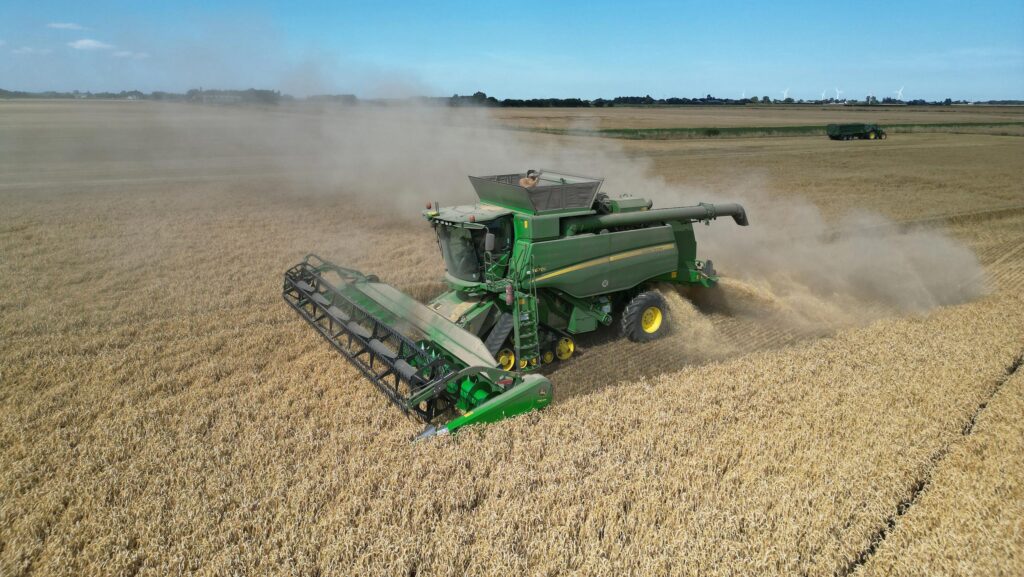Harvest 24: UK wheat yields down 7%, says AHDB report
 © Tim Scrivener
© Tim Scrivener While harvest is progressing well, yields are generally proving disappointing, with averages down for winter wheat, winter barley and oilseed rape.
Milling wheat protein levels are also looking down.
However, the standout horror result is winter barley at 21% below the five-year mean in the East Midlands.
See also: How a Suffolk Breckland farm has transformed the health of its soils
Wheat
The wheat harvest in the UK was 37% complete in the week ending 14 August.
The most progress was reported in the East Midlands, where harvest was 65% complete, and in the South East at 48% complete.
While harvest has progressed well, there are still fields thath are not fit.
This is especially true where crops are thinner and secondary tillering has taken place.
It is expected that the wheat harvest in Scotland and the North East is at least a week to two weeks away.
This year, progress reflects the total wheat area, including spring wheat.
The extreme weather meant some winter varieties were planted later, plus there is a greater spring wheat area than usual.
However, progress still looks to be ahead of both last year.
Then, just 5% of winter wheat in GB had been cut, and the five-year average for winter wheat (25% complete).
Yields
At an average of 7.5 t/ha, reported yields in the UK are down 7% on the five-year average.
Lower yields are reported in all regions, except the East, where the five-year average was observed.
Quality
- The specific weight of milling samples has been encouraging, averaging 76-77kg/hl. Some feed samples have exceeded 80kg/hl.
- There are no problems reported with Hagberg Falling Numbers.
- Early reports of milling wheat proteins have been disappointing. Group 1 samples have averaged 11.5% to 12%, and some samples have exceeded 13%, but these are rare.
Winter barley
The winter barley harvest is all but complete in the UK, ahead of last year’s 94% complete.
There is a small proportion left to be cut in Northern Ireland.
Yields
The average winter barley yield is 6.3t/ha, down 11% on the UK five-year average.
There are big differences in yields between regions.
Winter barley yields in the East were up 22% on average.
They were down in all other regions, except the South East, where the five-year average level was seen.
The largest decline was observed in the East Midlands, with yields 21% below average.
Quality
Winter malting barley quality is good, although there have been some lower bushel weights and subsequently lower screenings (retentions on a 2.5mm sieve).
There were also some comments regarding increased admix, primarily volunteer cereals or secondary growth.
- Specific weights are coming in between 59-72kg/hl, with an average of 64kg/hl.
- Screening retentions (on a 2.25mm sieve) for winter barley are averaging 88%, but with a range of 85-98%. This is a little lower than normal due to a smaller grain size.
- Grain nitrogen (for malting varieties) have averaged 1.5% with a range of 1.3-1.6%. This is low for winter malting barley, where maltsters typical look for grain nitrogen of up to 1.75%.
- There are no reported problems with germination in the winter malting crop.
Winter oilseed rape
The winter OSR harvest is almost complete, with 93% of the UK area harvested up to 14 August.
This is ahead of the 76% by the same stage in 2023 and 77% on average over the past five-years (GB).
Most of the uncut crop are in parts of Scotland and the west of England.
Yields
Yields are down across all regions, except in the East.
Yields are down 9% overall across the UK, at an average 2.93t/ha.
The greatest decline in yields was reported in Yorkshire and the Humber, down 29% on the five-year average.
Declines in yield of greater than 20% were also observed in the West Midlands and South West.
Yields were better on lighter ground.
- The average oil content is reported to be 45%, with very few samples below 44%.
- Moisture levels for oilseed rape vary from 6.7% in the East to 10.2% in the North West.
Spring barley
Across the UK, only 7% of the surveyed area had been cut at the time of reporting.
This is ahead of last year, when 5% of the GB area had been harvested, but slightly behind the five-year average of 9% complete.
Spring barley harvest is under way in the East and in Yorkshire and the Humber.
Anecdotally, substantial progress has been made in the east of England, with as much as 50% of the crop cut on some farms.
However, this is not the case for farms within this survey.

